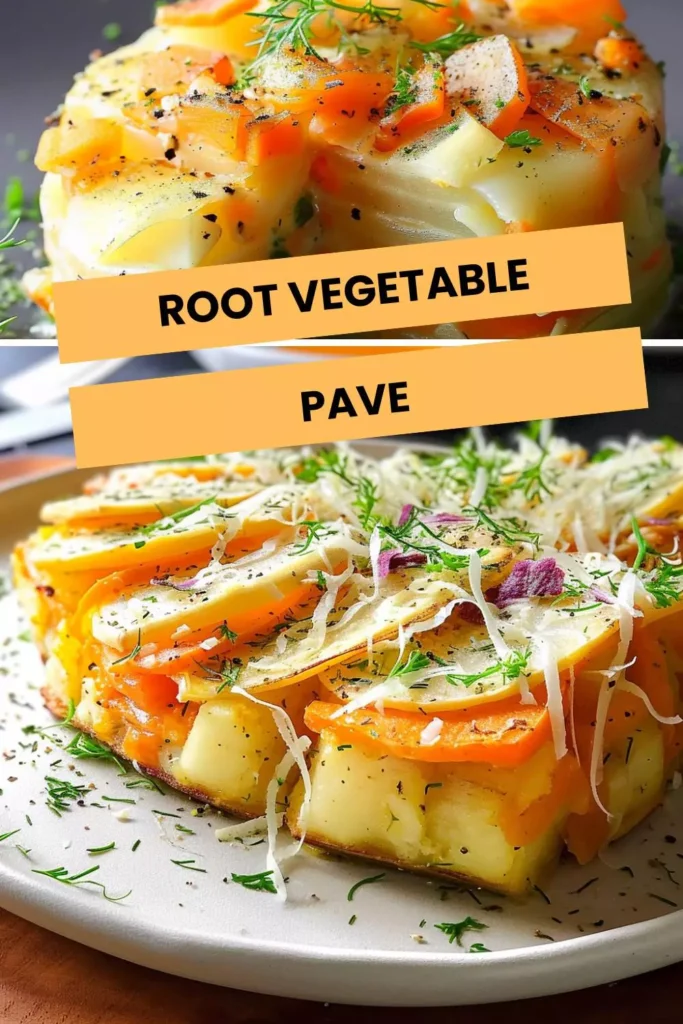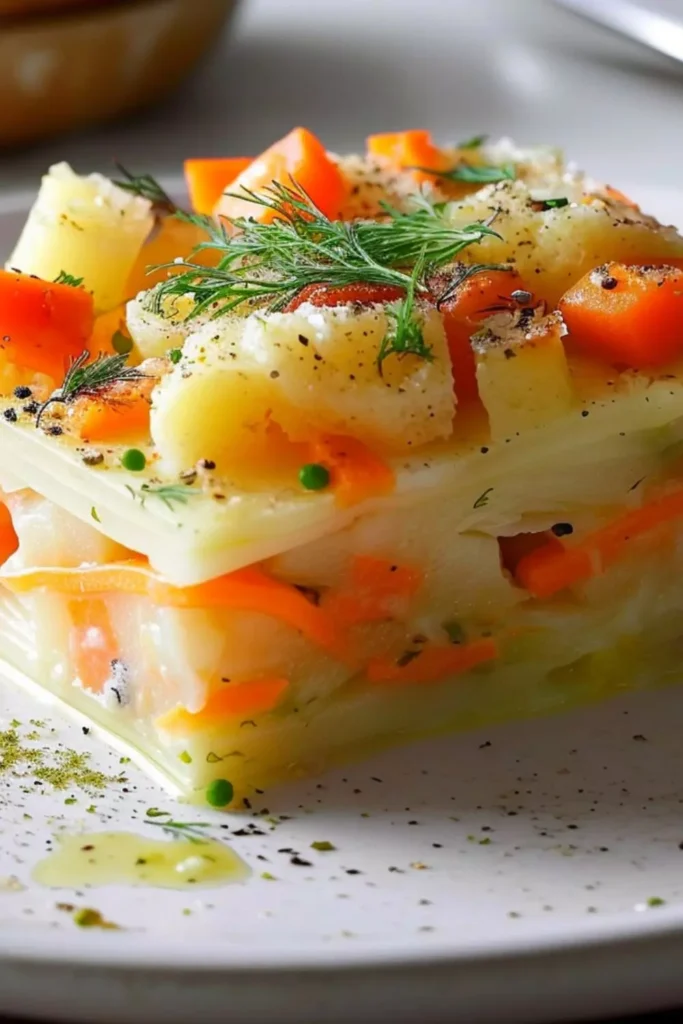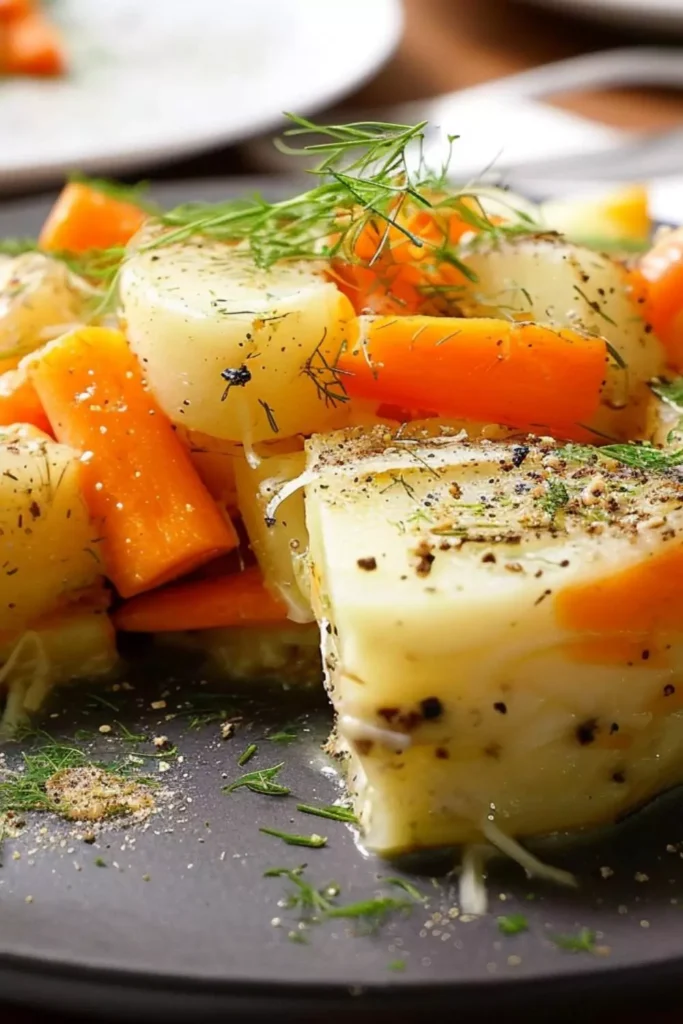Root vegetable pave is a delightful side dish that is sure to impress your guests. The combination of root vegetables such as potatoes, sweet potatoes, and carrots is combined with a savory blend of herbs and spices to create a delicious and nutritious dish.
This easy-to-make recipe is perfect for any occasion, be it a weeknight dinner or a special gathering. Plus, the leftovers make for a tasty lunch the next day!

What is root vegetable pave?
Root vegetable pave is a layered side dish made with a variety of root vegetables and herbs. It is typically made with potatoes, sweet potatoes, and carrots, but any root vegetable can be used.
The vegetables are layered in a baking dish and topped with a savory blend of herbs and spices. The dish is then baked until the vegetables are tender and lightly browned.
Why You’ll Love this root vegetable pave?
Rich Flavors: Root vegetables, such as potatoes, sweet potatoes, carrots, and parsnips, have distinct and rich flavors that can create a delicious and well-balanced dish.
Texture Variation: A pavé typically involves layering thinly sliced root vegetables, creating a dish with a variety of textures – from crispy edges to soft interiors. This textural interplay can be enjoyable to eat.
Versatility: Root vegetable pavé can be versatile, allowing you to experiment with different combinations of vegetables, herbs, and seasonings to suit your taste preferences.
Eye-Catching Presentation: When cooked and sliced, a root vegetable pavé can have a visually stunning appearance. The layers of different-colored vegetables can create an attractive and elegant dish, making it suitable for special occasions.
Health Benefits: Root vegetables are often nutrient-dense, providing essential vitamins, minerals, and dietary fiber. Depending on the specific vegetables used, a pavé can be a nutritious addition to your diet.
Adaptability: You can customize the recipe to meet dietary preferences or restrictions. Whether you’re vegetarian, vegan, or follow a specific diet, there are various ways to make a root vegetable pavé that suits your needs.
Creative Cooking: Making a root vegetable pavé involves a level of culinary creativity. From choosing the vegetables to arranging the layers, the process can be enjoyable for those who love experimenting in the kitchen.
Satisfying Comfort Food: The warmth and heartiness of root vegetables, especially when cooked to perfection, can evoke a sense of comfort and satisfaction, making it a comforting dish.
You’ll also like the following Appetizer recipes!
The Ingredients
Different Root Vegetables (such as Potatoes, Sweet Potatoes, Carrots, Parsnips, and Beets): This diverse selection of root vegetables forms the heart of the dish, creating a medley of earthy flavors and vibrant colors. Each vegetable contributes its unique taste and texture, offering a rich and hearty foundation for the root vegetable pave.
Fresh Herbs (Rosemary, Thyme, or Sage) for Garnish (Optional): These fresh herbs serve as an optional garnish, providing an aromatic flourish to enhance the overall sensory experience. The herbs add a layer of fragrance and subtle flavor, complementing the earthiness of the root vegetables.
Premium Olive Oil: The premium olive oil serves as a liquid gold drizzle, coating the vegetables and contributing a luxurious richness. Beyond its flavorful profile, olive oil also aids in roasting, ensuring the vegetables achieve a golden and crispy exterior.
Salt and Pepper to Taste: These classic seasonings play a crucial role in elevating the dish’s flavors. Salt enhances the natural taste of the vegetables, while pepper adds a subtle kick, creating a well-balanced seasoning dance that ties the elements together.

Directions
Step 1: Preheat the Oven:
Begin by preheating your oven to a temperature of 375°F (190°C), creating the perfect environment for roasting your root vegetable pave.
Step 2: Prepare the Vegetables:
Take the root vegetables of your choice, peel them, and then thinly slice them into uniform rounds. For precision, consider using a mandoline to achieve consistent thickness.
Step 3: Assemble the Layers:
Artfully arrange the sliced root vegetables in layers within a baking dish. To enhance visual appeal, you can alternate different types of vegetables, creating a vibrant and colorful presentation.
Step 4: Drizzle with Olive Oil:
Drizzle the layers of root vegetables with premium olive oil, ensuring that each slice receives a light and even coating.
Step 5: Season Well:
Generously season the layers of root vegetables with salt and pepper. This step is crucial in bringing out the natural flavors of the root vegetables.
Step 6: Add Fresh Herbs (Optional):
Elevate the aroma and flavor profile by sprinkling fresh herbs like rosemary, thyme, or sage over the top of the vegetable layers.
Step 7: Cover and Bake:
Cover the baking dish with foil and place it in the preheated oven. Allow the vegetables to bake for approximately 45-60 minutes or until they achieve a tender consistency. Verify this by inserting a fork into the layers.
Step 8: Uncover and Brown (Optional):
If you desire a golden-brown top for added visual appeal, uncover the baking dish during the last 15 minutes of the baking process.
Step 9: Garnish and Serve:
Once the root vegetable pave is done baking, remove it from the oven. Consider garnishing with additional fresh herbs for a final touch of flavor and aesthetics.
Notes
– For an extra layer of flavor, try adding some freshly chopped herbs to the herb and spice mixture.
– If you don’t have all of the herbs and spices on hand, you can substitute with a blend of your favorite herbs and spices.
– If you prefer a softer texture, you can cover the dish with foil before baking.
– If you want to add some protein to the dish, try adding some cooked diced chicken or beans.
– For a vegan option, try substituting the olive oil with a vegan-friendly oil.

Nutrition Information
Serving size: 1/8
Calories: 143
Total Fat: 4.5g
Saturated Fat: 0.6g
Trans Fat: 0g
Cholesterol: 0mg
Sodium: 22mg
Total Carbohydrates: 24.5g
Dietary Fiber: 4.5g
Sugars: 4g
Protein: 3.2g
Serving Suggestions
– Serve root vegetable pave as a side dish alongside your favorite protein.
– Top with a dollop of Greek yogurt for a creamy, tangy flavor.
– Add a sprinkle of Parmesan cheese for a cheesy, nutty flavor.
– Serve over a bed of greens for a light and healthy lunch.
– Top with a fried egg for a hearty breakfast.
What other substitute can I use in root vegetable pave?
– Sweet potatoes can be replaced with yams or squash.
– Carrots can be replaced with parsnips, turnips, or rutabaga.
– Herbs and spices can be replaced with garlic, onion powder, or smoked paprika.
– Olive oil can be replaced with melted butter or coconut oil.

Equipment
- knife
- chopping board
- Parchment paper
- Baking dish
Ingredients
- 8-10 Different Root Vegetables such as Potatoes, Sweet Potatoes, Carrots, Parsnips, and Beets, the earthy medley
- Fresh Herbs Rosemary, Thyme, or Sage for Garnish (Optional), the aromatic flourish
- 4-6 Tablespoons of Premium Olive Oil the liquid gold drizzle
- Salt and Pepper to Taste for the perfect seasoning dance
Instructions
- Preheat your oven to 375°F (190°C).
- Peel and thinly slice the root vegetables into uniform rounds. You can use a mandoline for precision.
- Create layers of the sliced root vegetables in a baking dish. You can alternate the vegetables for a colorful presentation.
- Drizzle the layers with premium olive oil, ensuring each slice is lightly coated.
- Season the vegetable layers generously with salt and pepper. This enhances the natural flavors of the root vegetables.
- Sprinkle fresh herbs like rosemary, thyme, or sage over the top for added aroma and flavor.
- Cover the baking dish with foil and bake in the preheated oven for about 45-60 minutes or until the vegetables are tender. Check by inserting a fork into the layers.
- If you desire a golden-brown top, uncover the dish during the last 15 minutes of baking.
- Once done, remove from the oven. Garnish with additional fresh herbs if desired.
Notes
- For an extra layer of flavor, try adding some freshly chopped herbs to the herb and spice mixture.
- If you don’t have all of the herbs and spices on hand, you can substitute with a blend of your favorite herbs and spices.
- If you prefer a softer texture, you can cover the dish with foil before baking.
- If you want to add some protein to the dish, try adding some cooked diced chicken or beans.
- For a vegan option, try substituting the olive oil with a vegan-friendly oil.
Nutrition
Frequently Asked Questions
Q1. How long does root vegetable pave last?
A1. Root vegetable pave can be stored in the refrigerator for up to 3 days.
Q2. Is root vegetable pave vegan?
A2. Yes, it can be made vegan by substituting the olive oil with a vegan-friendly oil.
Q3. Can I use other vegetables in root vegetable pave?
A3. Yes, any root vegetable can be used in root vegetable pave.
Q4. What can I serve with root vegetable pave?
A4. Root vegetable pave can be served as a side dish alongside your favorite protein.
Q5. How do I reheat root vegetable pave?
A5. To reheat, add a little water to the baking dish and cover with foil. Bake at 350°F for 15-20 minutes, or until heated through.
Q6. Is root vegetable pave healthy?
A6. Yes, root vegetable pave is a nutritious side dish that is packed with vitamins, minerals, and fiber.
Q7. Is root vegetable pave gluten-free?
A7. Yes, root vegetable pave is naturally gluten-free. However, always check the ingredients list for any potential sources of gluten.
Conclusion
Root vegetable pave is an easy-to-make side dish that is sure to please everyone at the table. It’s a great way to get more vegetables into your diet, and the savory blend of herbs and spices adds an extra layer of flavor.
Plus, you can easily customize the dish to suit your taste. So, why not give this delicious root vegetable pave a try?
You’ll also like these latest recipes!
- Strawberry Long Island Iced Tea Copycat Recipe
- How to make Japanese Chicken Nuggets
- Wingstop Cajun Wings

Rebecca Novak is a trained chef with over 10 years of experience in the food industry. She has worked in both fine dining and casual Hungarian restaurants and specializes in creating dishes using fresh, seasonal ingredients. She also loves exploring different cuisines worldwide, which allows her to bring unique flavors and ideas to the recipes she creates for Hungarianchef.com. Read more
